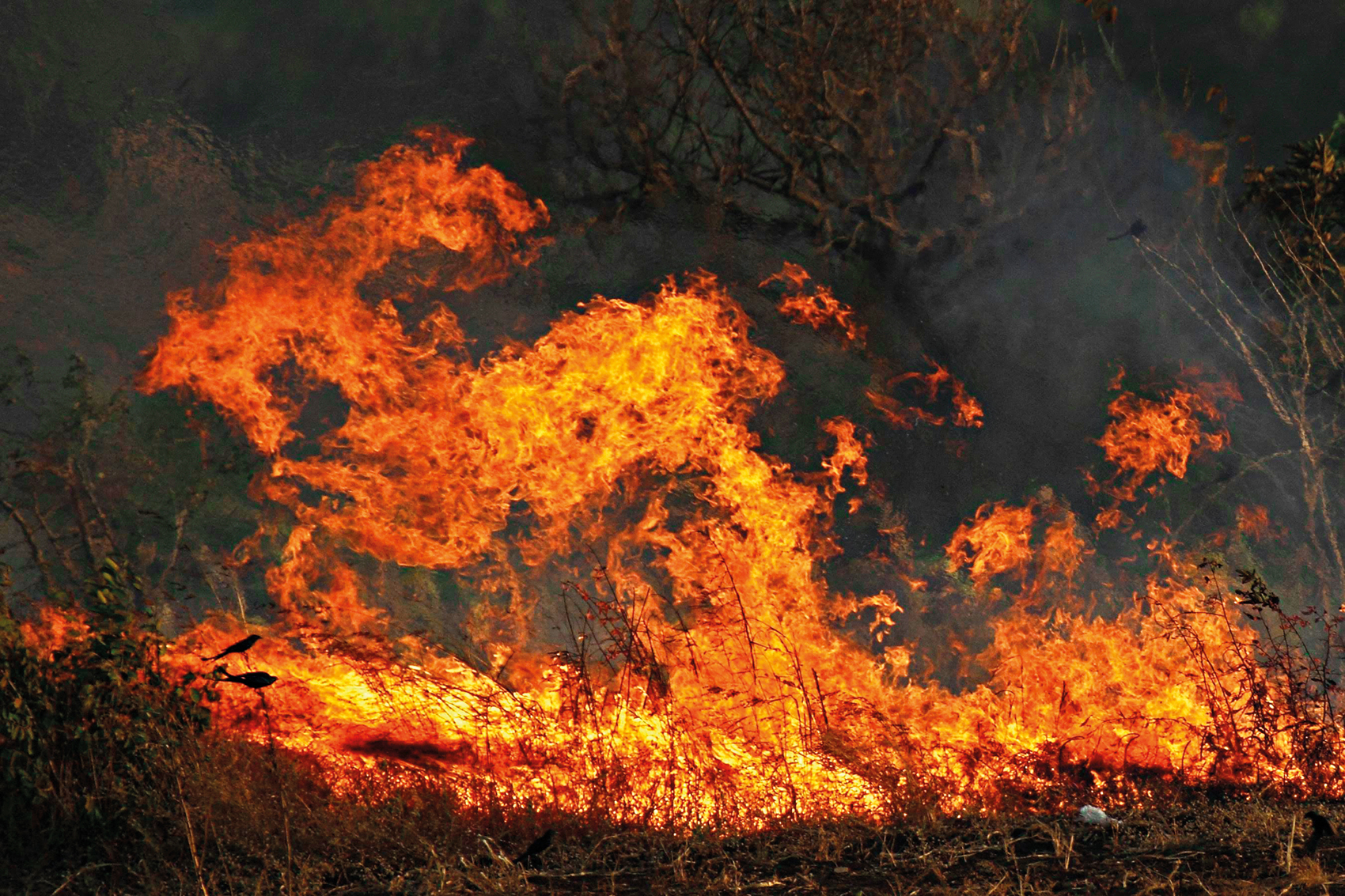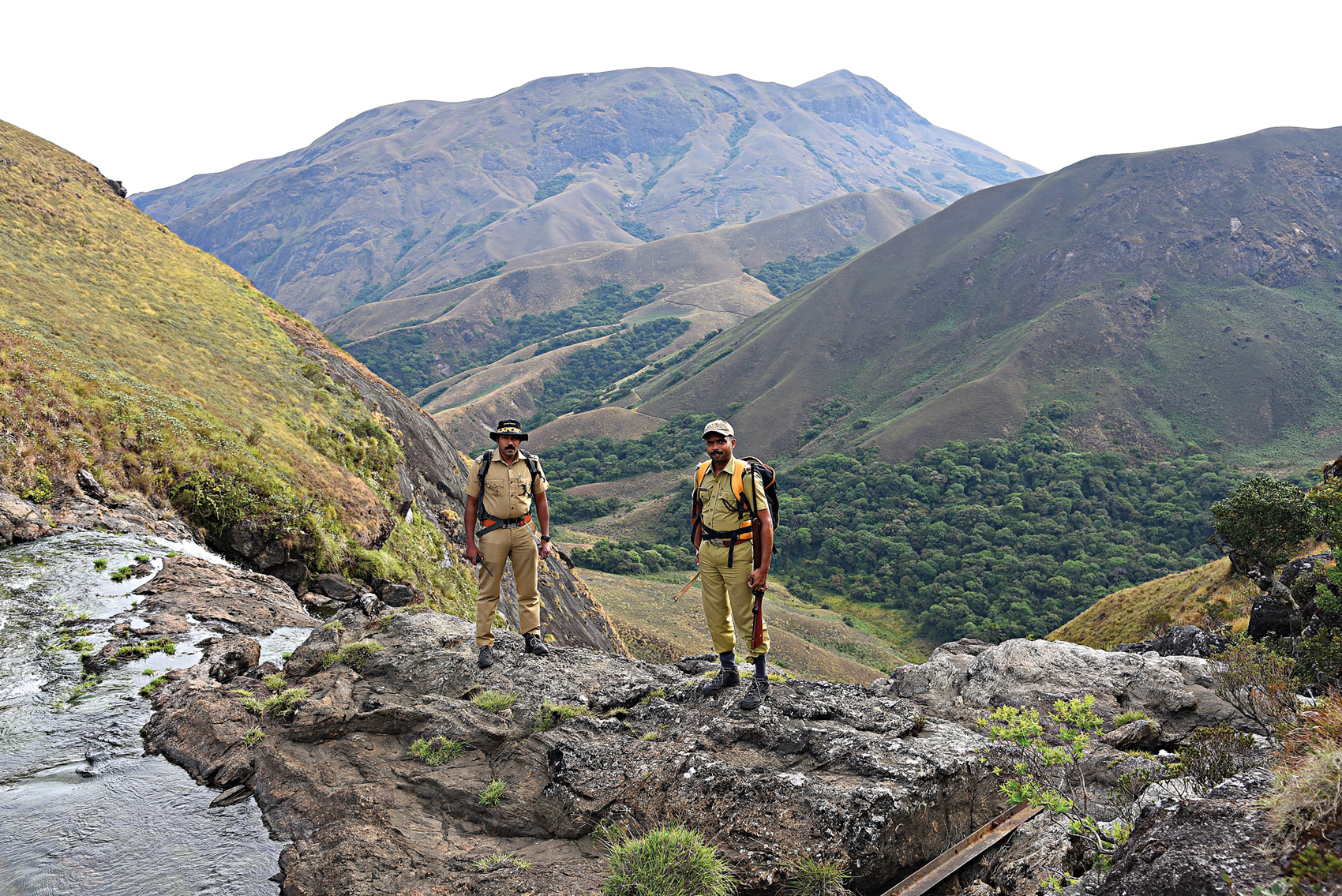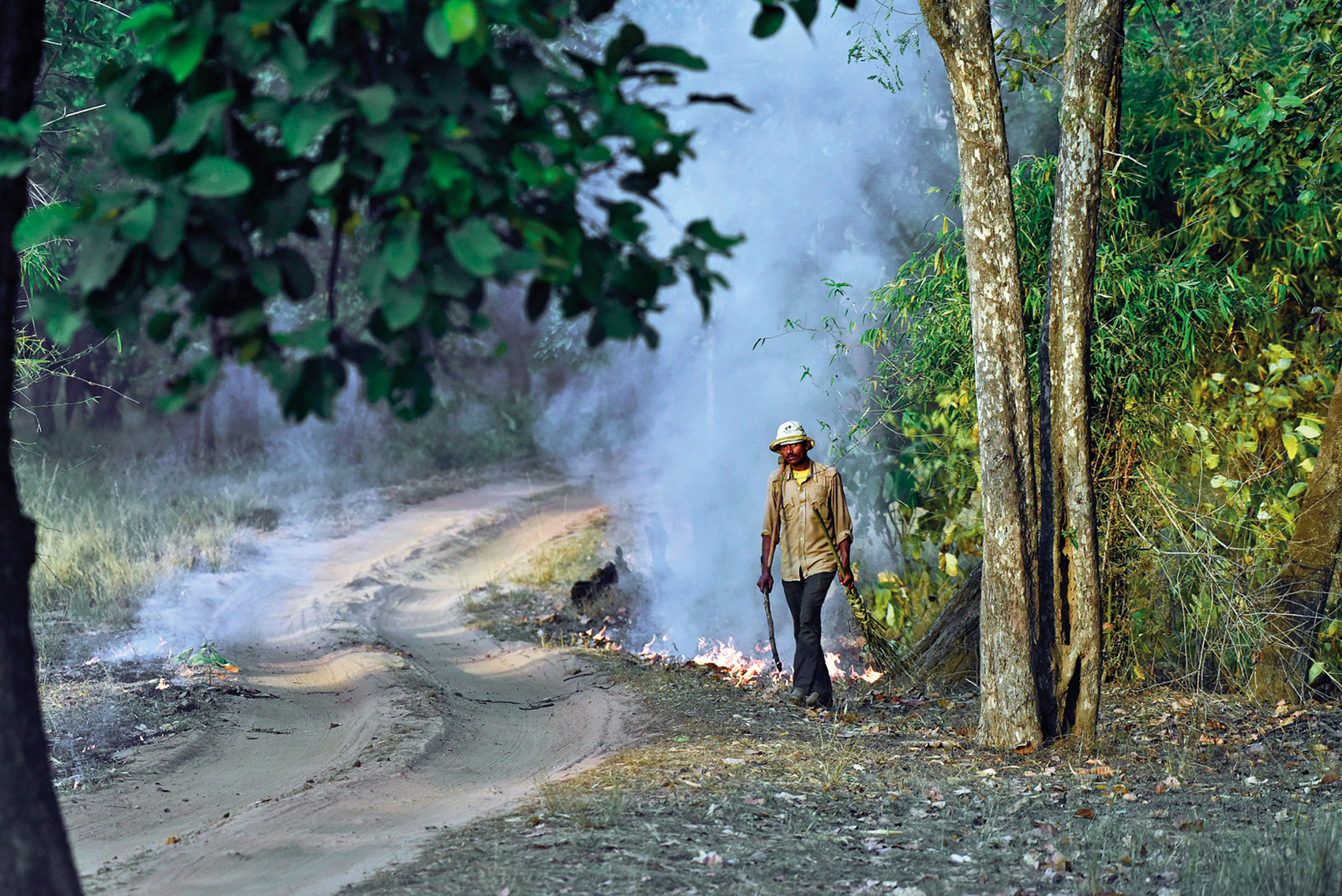Conflagrations
First published in Sanctuary Asia,
Vol. 40
No. 10,
October 2020
How our under-equipped forest staff fights fires
By Rizwan Mithawala
Dnyaneshwar Shinde stopped at a pool of water by the foot of a mighty banyan on a drying streambed, dipped his cupped hands in the water, and splashed some on his face. He did not drink it. I asked him if he would, were he unbearably thirsty on an afternoon patrol in the hot month of May. He would, he said, but not from the same pool, as animals drank from it, and began demonstrating how he would make a jheera to access sand-filtered water. He showed me how he would dig a pit with his bare hands, around four feet downstream from the pool, to get potable water. It reminded me of how elephants dig their own little wells on stream beds, using their feet and multitasking trunk, quenching their own thirst, and also providing life-giving water to smaller animals.
 A Forest Survey of India report states that over 95 per cent of forest fires are of anthropogenic origin, either accidental or intentional. Forest fires pose serious threats to biodiversity, destroying everything in their wake from trees and megafauna, to the forest floor and the thousands of microorganisms that make the wilderness thrive. Photo:Vidyadhar Shelke.
A Forest Survey of India report states that over 95 per cent of forest fires are of anthropogenic origin, either accidental or intentional. Forest fires pose serious threats to biodiversity, destroying everything in their wake from trees and megafauna, to the forest floor and the thousands of microorganisms that make the wilderness thrive. Photo:Vidyadhar Shelke.
Preventing Fires
We were not walking in elephant country, but one of the most rugged terrains in the highlands of Central India, the Melghat Tiger Reserve, which had elephants some centuries ago. Shinde was a forest guard with the Maharashtra Forest Department, in charge of a beat in the core zone of the tiger reserve. Speaking of summers and thirst, forest guards almost always speak of the fire season. Officially beginning on February 15 and ending on June 15 in Central Indian forests, the fire season is when State Forest Departments are on high alert and fire prevention and control is on every forest officer and guard’s mind.
Melghat, a confluence of hills, is a prime tiger habitat harbouring a sizeable population. Among the first nine tiger reserves notified in 1973 under Project Tiger, it now spans 2,768 sq. km., out of which 1,500 sq. km. is considered critical tiger habitat. Protecting these forested hills and tigers, and other endangered wildlife that calls them home, isn’t an easy task, especially in the fire season. “The simple formula to limit the damage by a fire is to deploy more forest staff and fire watchers at the location in less time,” says Dr. Sivabala S., who was Deputy Conservator of Forests for the Sipna Division of the reserve till July this year. But it isn’t so simple, he adds, and goes on to explain the larger framework to ensure the prevention and control of fires.
Prevention is the first line of defence, and a strong one, so preventive measures are undertaken at multiple levels. Fire lines, also known as fire breaks, are created early on, in winter, by clearing strips of vegetation and combustible leaf litter. Forest guards in this part of India call it ‘patta nikalna’, meaning clearing a strip, to stop the spread of fire. As most forest fires in India are caused by human activity (while accidental fires can be caused by un-extinguished beedis, shepherds burning the undergrowth to catalyse the growth of fodder for their cattle, villagers lighting fires to catalyse fresh sprouting of tendu leaves, or to clear the leaf litter for easy collection of fallen flower and fruit; arson, in retaliation of the restrictions imposed by the Forest Department, is also prevalent), it is important for the Forest Department to keep the villagers on its side. The Melghat Tiger Reserve has started a cash reward system for “Zero Fire” villages to achieve this goal, with villages in the core zone having even higher cash rewards up for grabs if they are able to ensure that the forests adjacent to their villages have had no fire incidents. The incentive can turn even miscreants into forest protectors with watchful eyes.
Detecting Fires
The next step is timely detection of fires, for which the department is on high-alert throughout the season, and uses modern technology as well as time-tested methods. The department relies on email alerts from NASA’s Fire Information for Resource Management System (FIRMS), which provides near real-time active fire data from its satellites, in addition to fire alerts via SMS from the Forest Survey of India (FSI). Information from these alerts is disseminated by the two fire cells, which work 24/7 during the fire season. The fire cells transmit the information so that firefighters can be deployed to the location in the most time efficient way with optimum firefighting equipment, food and water.
But as the satellite data is not received in real time, the department also relies heavily on the age-old system of fire watchers stationed atop watchtowers which are built at high elevations and spread across the reserve, offering panoramic views of the surroundings for surveillance. “In many instances, we have been able to detect fires faster from watchtowers; it’s a trusted system,” says Amit Shinde, a Range Forest Officer at the reserve.
Trained fire-watchers are hired especially for the fire season on daily wage, and are equipped with blowers (which are used to blow air at the fire in the direction opposite to its natural trajectory), torchlights and first-aid kits. These men from nearby villages are seasoned firefighters, and know the landscape well. In areas which are not accessible by vehicles, they climb steep terrain carrying equipment, water and food, making their way to the fire through dense vegetation.
 Firefighting poses a direct threat to the lives of forest guards and forest watchers, and often causes, apart from external injuries, internal health problems such as extreme dehydration and insomnia. Photo:Dr. Anish Andheria.
Firefighting poses a direct threat to the lives of forest guards and forest watchers, and often causes, apart from external injuries, internal health problems such as extreme dehydration and insomnia. Photo:Dr. Anish Andheria.
Monitoring Fires
A recent addition to the firefighting efforts is drone surveillance. A squad of guards trained in operating drones has been put together by M.S. Reddy, Additional Principal Chief Conservator of Forests and Field Director, Melghat Tiger Reserve. Aerial photography helps assess the spread of a live fire and measure the area damaged after a fire, reduces the risk of burn injuries drastically, and also helps catch offenders, especially from notorious villages, by flying drones over those areas at odd hours.
Post-fire operations include measuring the area damaged, and intensive monitoring of that area, to prevent retaliatory fires in the future. A combination of satellite imagery, drone photography and GPS applications is used to measure the exact extent of damage. “Thorough assessment helps us prepare ourselves for the next year,” says Dr. Sivabala.
Intentionally lit fires by people from villages skirting the parks spread fast as they are lit at multiple locations at the same time. Such fires can become uncontrollable, and take days to douse, destroying large swathes of standing forest, including countless animals and micro-fauna. Forest guards and watchers fight these fires at the frontlines, braving burns, and sometimes succumbing to them. The most recent incident, from February this year, is of forest watchers K.U. Divakaran (43) and A.K. Velayudhan (54), who were trapped and killed by a fire that they were trying to douse in the Vadakkanchery Forest Range in the Thrissur district of Kerala.
 To keep fires in check, forest staff create fine lines, also known as fire breaks, by clearing inflammable material like leaf litter, during the drier months. Photo:Dr. Anish Andheria.
To keep fires in check, forest staff create fine lines, also known as fire breaks, by clearing inflammable material like leaf litter, during the drier months. Photo:Dr. Anish Andheria.
Tackling Fires
Firefighting is the most challenging part of the forest guard and forest watchers’ job. It is a direct threat to their lives, and often causes, apart from external injuries, a lot of internal health problems. Many suffer from extreme dehydration and loss of sleep for days on end, which may lead to further health complications. “The problems start from the next day, and last for at least three days,” says Shinde. “The eyes turn red, it’s difficult to urinate, the appetite for food dies, and I feel like drinking water all the time.”
Forest fires destroy the forest floor, which is one of the most important components of the ecosystem, teeming with countless arthropods and decomposers that recycle complex plant and animal matter and return it back to the soil. As a fire spreads, it indiscriminately destroys everything in its wake – from microbes to mammals. One evening in May 2016, Shinde and other guards and watchers, equipped with fire blowers, reached a fire location and found a nilgai and its young surrounded by fire. Using their blowers, they were able to clear a gap and create an escape route for the two animals, saving their lives. Shinde recounts the incident as one that brought him immense fulfillment.
In the last three years, the Melghat Tiger Reserve brought down the area under forest fires from 107 sq. km. to 10 sq. km. This was made possible with real-time monitoring, quick responses, community involvement and, above all, the dedicated and relentless efforts of guards and watchers on the frontline.
“The role played by the Forest Department in protecting large-sized animals and trees seems to catch everyone’s eye. However, to my mind, fighting a forest fire to save even one hectare of forest or grassland is more life threatening for our frontline forest staff and fire-watchers than guarding the forest from poachers. Frequent fires impact the forest in innumerable ways – from destroying the carbon-fixing microbes in the soil, to causing soil desiccation, rendering it infertile, to drastically reducing the biodiversity of the area, to assisting the proliferation of weeds such as Lantana and Parthenium that further intensify the loss of biodiversity,” says Dr. Anish Andheria, President of the Wildlife Conservation Trust.
People and organisations interested in conservation of terrestrial habitats and species should help build the capacity of the Forest Department in preventing and fighting forest fires, asserts Dr. Andheria. “It can be done in many ways – by donating equipment and specialised clothing to increase efficiency of the forest staff in combating fires, while simultaneously reducing the risk of injury; by running campaigns in village schools to spread awareness about the ill-effects of forest fires on both villagers and biodiversity; by helping change age-old practices of minor forest produce (MFP) collection so that fire is not employed as a conduit to improve the yield of MFPs; and by developing innovative methods of collection of MFPs to achieve a win-win for both villagers and wildlife, especially outside Protected Areas.”
“The next time you see a forest watcher or forest guard, don’t forget to salute and acknowledge them for putting their life at risk year after year to safeguard India’s wildlife habitats and biodiversity from man-made forest fires that not only threaten terrestrial ecosystems, but accelerate our climate crisis,” concludes Dr. Andheria.
Rizwan Mithawala is a Conservation Writer with the Wildlife Conservation Trust and a Fellow of the International League of Conservation Writers.




